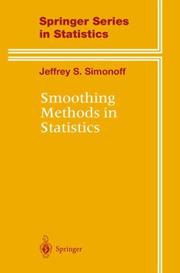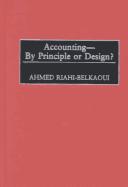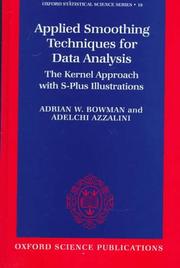| Listing 1 - 10 of 134 | << page >> |
Sort by
|
Book
ISBN: 3790809306 9783790809305 Year: 1996 Publisher: Heidelberg: Physica-Verlag,
Abstract | Keywords | Export | Availability | Bookmark
 Loading...
Loading...Choose an application
- Reference Manager
- EndNote
- RefWorks (Direct export to RefWorks)
Book
ISBN: 110861678X 1108686885 1108610242 Year: 2021 Publisher: Cambridge : Cambridge University Press,
Abstract | Keywords | Export | Availability | Bookmark
 Loading...
Loading...Choose an application
- Reference Manager
- EndNote
- RefWorks (Direct export to RefWorks)
This is a practical guide to P-splines, a simple, flexible and powerful tool for smoothing. P-splines combine regression on B-splines with simple, discrete, roughness penalties. They were introduced by the authors in 1996 and have been used in many diverse applications. The regression basis makes it straightforward to handle non-normal data, like in generalized linear models. The authors demonstrate optimal smoothing, using mixed model technology and Bayesian estimation, in addition to classical tools like cross-validation and AIC, covering theory and applications with code in R. Going far beyond simple smoothing, they also show how to use P-splines for regression on signals, varying-coefficient models, quantile and expectile smoothing, and composite links for grouped data. Penalties are the crucial elements of P-splines; with proper modifications they can handle periodic and circular data as well as shape constraints. Combining penalties with tensor products of B-splines extends these attractive properties to multiple dimensions. An appendix offers a systematic comparison to other smoothers.

ISBN: 0387947167 1461284724 1461240263 9780387947167 Year: 1996 Publisher: New York: Springer,
Abstract | Keywords | Export | Availability | Bookmark
 Loading...
Loading...Choose an application
- Reference Manager
- EndNote
- RefWorks (Direct export to RefWorks)
Mathematical statistics --- Smoothing (Statistics) --- Lissage (Statistique) --- Smoothing (Statistics).

ISBN: 1567205534 Year: 2003 Publisher: Westport, Conn. Praeger
Abstract | Keywords | Export | Availability | Bookmark
 Loading...
Loading...Choose an application
- Reference Manager
- EndNote
- RefWorks (Direct export to RefWorks)
Accountancy --- Accounting. --- Corporations --- Fraud. --- Income accounting. --- Smoothing (Statistics) --- Smoothing (Statistics).

ISBN: 363155687X Year: 2007 Publisher: Frankfurt am Main Lang
Abstract | Keywords | Export | Availability | Bookmark
 Loading...
Loading...Choose an application
- Reference Manager
- EndNote
- RefWorks (Direct export to RefWorks)
Income --- Smoothing (Statistics) --- Statistics --- Mathematical models
Book
ISBN: 1108912303 1108917402 9781108912303 9781108917407 Year: 2023 Publisher: New York, NY : Cambridge University Press,
Abstract | Keywords | Export | Availability | Bookmark
 Loading...
Loading...Choose an application
- Reference Manager
- EndNote
- RefWorks (Direct export to RefWorks)
Now in its second edition, this accessible text presents a unified Bayesian treatment of state-of-the-art filtering, smoothing, and parameter estimation algorithms for non-linear state space models. The book focuses on discrete-time state space models and carefully introduces fundamental aspects related to optimal filtering and smoothing. In particular, it covers a range of efficient non-linear Gaussian filtering and smoothing algorithms, as well as Monte Carlo-based algorithms. This updated edition features new chapters on constructing state space models of practical systems, the discretization of continuous-time state space models, Gaussian filtering by enabling approximations, posterior linearization filtering, and the corresponding smoothers. Coverage of key topics is expanded, including extended Kalman filtering and smoothing, and parameter estimation. The book's practical, algorithmic approach assumes only modest mathematical prerequisites, suitable for graduate and advanced undergraduate students. Many examples are included, with Matlab and Python code available online, enabling readers to implement algorithms in their own projects.
Book
ISBN: 110742433X 113934420X Year: 2013 Publisher: Cambridge : Cambridge University Press,
Abstract | Keywords | Export | Availability | Bookmark
 Loading...
Loading...Choose an application
- Reference Manager
- EndNote
- RefWorks (Direct export to RefWorks)
Filtering and smoothing methods are used to produce an accurate estimate of the state of a time-varying system based on multiple observational inputs (data). Interest in these methods has exploded in recent years, with numerous applications emerging in fields such as navigation, aerospace engineering, telecommunications and medicine. This compact, informal introduction for graduate students and advanced undergraduates presents the current state-of-the-art filtering and smoothing methods in a unified Bayesian framework. Readers learn what non-linear Kalman filters and particle filters are, how they are related, and their relative advantages and disadvantages. They also discover how state-of-the-art Bayesian parameter estimation methods can be combined with state-of-the-art filtering and smoothing algorithms. The book's practical and algorithmic approach assumes only modest mathematical prerequisites. Examples include Matlab computations, and the numerous end-of-chapter exercises include computational assignments. Matlab code is available for download at www.cambridge.org/sarkka, promoting hands-on work with the methods.
Dissertation
Year: 1989 Publisher: [S.l.]: [chez l'auteur],
Abstract | Keywords | Export | Availability | Bookmark
 Loading...
Loading...Choose an application
- Reference Manager
- EndNote
- RefWorks (Direct export to RefWorks)
Lissage (analyse numérique) --- Smoothing (Numerical analysis) --- Approximation et developpements --- Splines

ISBN: 0198523963 9780198523963 Year: 1997 Volume: 18 Publisher: Oxford: Clarendon,
Abstract | Keywords | Export | Availability | Bookmark
 Loading...
Loading...Choose an application
- Reference Manager
- EndNote
- RefWorks (Direct export to RefWorks)
Here is a clear exposition of nonparametric smoothing methods for statisticians. The focus is applied rather than theoretical, with a large number of illustrations from different disciplines.
Mathematical statistics --- Smoothing (Statistics) --- Smoothing (Statistics). --- Basic Sciences. Statistics --- Experimental Design. --- 519.5 --- Curve fitting --- Graduation (Statistics) --- Roundoff errors --- Statistics
Dissertation
Year: 2025 Publisher: Liège Université de Liège (ULiège)
Abstract | Keywords | Export | Availability | Bookmark
 Loading...
Loading...Choose an application
- Reference Manager
- EndNote
- RefWorks (Direct export to RefWorks)
Title: Image Smoothing in Neuroimaging: Effect of Gaussian vs. Tissue-Specific Approaches in Statistical Analysis Author: Jacquemin Antoine Section: "Ingénieur civil biomédical" Academic Year: 2024-2025 Promotor: Phillips Christophe This study aims to improve spatial smoothing approaches in quantitative and functional magnetic resonance imaging (qMRI and fMRI) by generalizing Tissue-SPecific smOOthing compeNsated (TSPOON) and comparing its performance with Tissue-Weighted Smoothing (TWS) and traditional Gaussian Smoothing. The work utilizes a qMRI dataset from the Wellcome Trust Centre for Neuroimaging (London) and the hMRI toolbox, a new collaborative toolbox for neuroimaging research, with the potential integration of the generalized TSPOON approach into the toolbox. To achieve these goals, the study implements TSPOON by developing optimized tissue-specific binary masks to preserve tissue specificity. TWS, by contrast, employs continuous modulated warped tissue weights. The results show that TSPOON provides consistently lower effective smoothing than TWS. It is more sensitive to pronounced signal variations near tissue boundaries, thereby enhancing specificity. In contrast, TWS is better at capturing subtle variations within homogeneous regions, offering greater sensitivity. Notably, smoothing-induced differences in both qMRI and fMRI are predominantly observed at the tissue boundaries, highlighting the effects of partial volume biases. These findings underline the complementary nature of TWS and TSPOON. TWS is suited for exploratory studies emphasizing sensitivity, while TSPOON is optimal for analyses requiring robust tissue delineation and specificity. The choice of method should align with the study’s objectives (whether broad signal coverage or precise detection of localized effects is prioritized). Future perspectives include refining the design of tissue-specific masks, extending the evaluation of these methods to other imaging modalities such as diffusion-weighted imaging and positron emission tomography and publishing the generalized TSPOON implementation to provide a new, versatile smoothing option for neuroimaging researchers.
Spatial Smoothing --- Tissue-Specificity --- qMRI --- fMRI --- Neuroimaging --- TSPOON --- TWS --- Gaussian Smoothing --- Partial Volume Effect --- Ingénierie, informatique & technologie > Multidisciplinaire, généralités & autres
| Listing 1 - 10 of 134 | << page >> |
Sort by
|

 Search
Search Feedback
Feedback About UniCat
About UniCat  Help
Help News
News